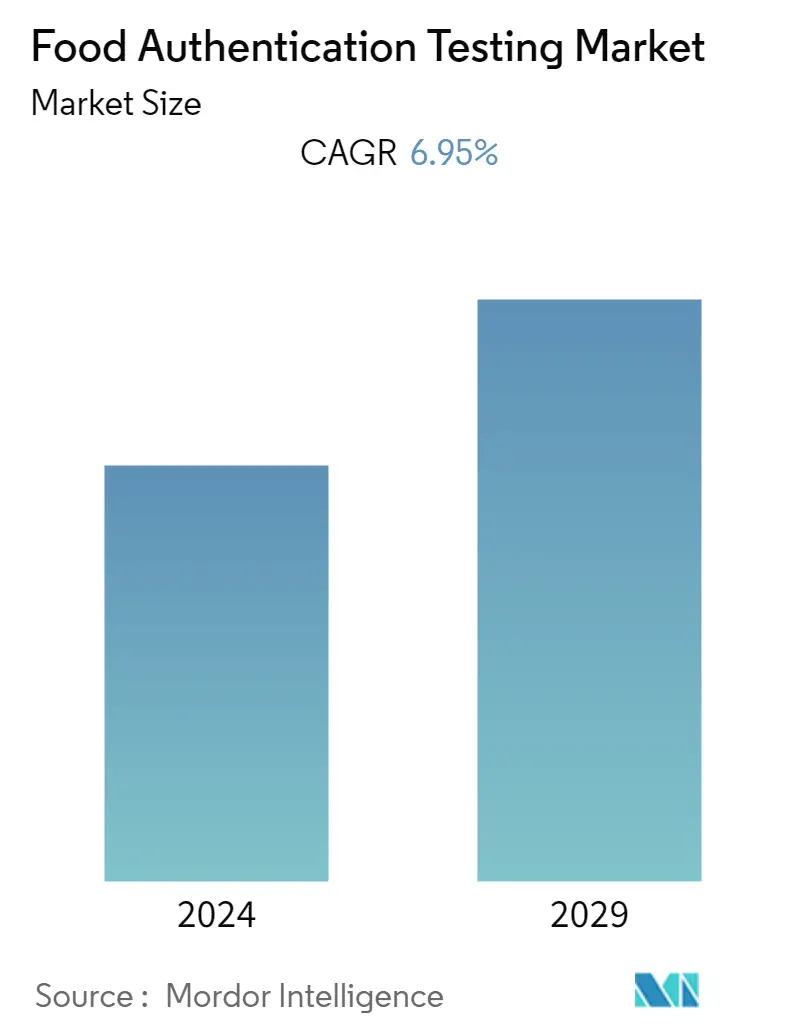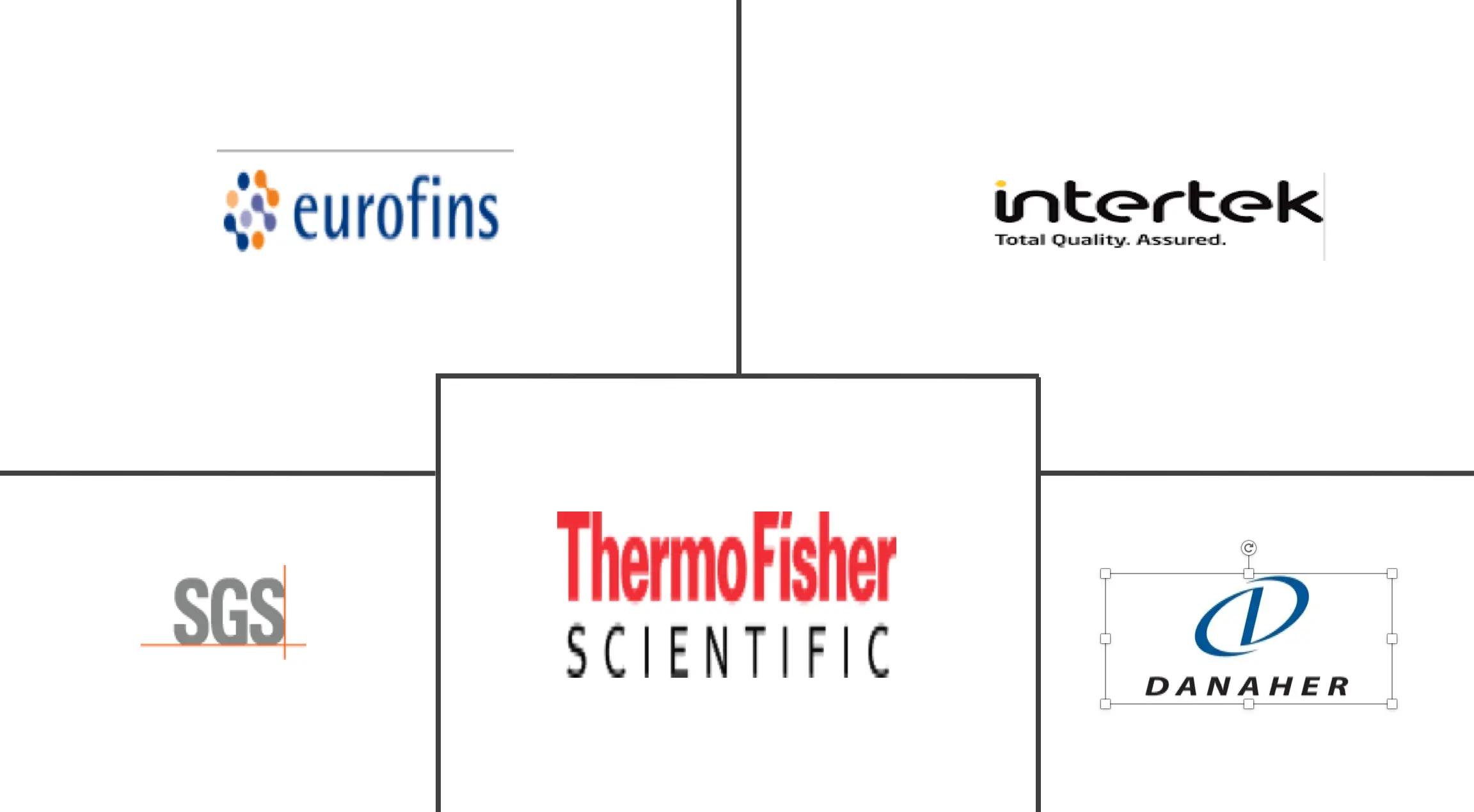Market Size of Food Authentication Testing Industry

| Study Period | 2019 - 2029 |
| Base Year For Estimation | 2023 |
| CAGR | 6.95 % |
| Fastest Growing Market | Asia Pacific |
| Largest Market | Europe |
| Market Concentration | High |
Major Players
*Disclaimer: Major Players sorted in no particular order |
Food Authenticity Testing Market Analysis
The global food authentication testing market (henceforth, referred to as the market studied) is projected to register a CAGR of 6.95% during the forecast period, 2021 - 2026.
With the consumer aiming to purchase more authentic, healthy and branded food products during the COVID-19 period, due to the risk of COVID-19 and other viruses in them, therefore the application of services such as food authentication, had further propelled in the year 2020 as compared to other previous years.
Amid the growing prevalence of food fraud in the industry, including the deliberate substitution of ingredients, misleading consumers with false claims, and disruptive labeling, consumers have become skeptical about the authentication of food products meant to serve specific demands, such as vegan, free-form, organic, and others. This, in turn, has led the food manufacturers to opt for food authentication techniques as the most effective way to differentiate their products from conventional offerings, to capture substantial shares in the market.
However, the complexity to maintain the authenticity of the end product, considering identification and management from each stakeholder of the supply chain, makes the food manufacturers opt-out of authentication testing. Moreover, testing, primarily being a voluntary adoption, is perceived to be an extra expense for small manufacturers of the developing regions, like Asia-Pacific and Africa. The testing method poses a budget constraint for the food companies, further posing a restraint to the market.
Food Authenticity Testing Industry Segmentation
Food authentication is the process that verifies that food is in compliance with its label description. The food authentication testing market studied is segmented by technology into PCR Technique, DNA Sequencing/Barcoding, Next-generation Sequencing, ELISA, NMR Technique/Molecular Spectrometry, Mass Spectrometry (Liquid or Gas Chromatography), and other technologies. Based on geography, the market is segmented into North America, Europe, Asia-Pacific, South America, Middle-East and Africa. For each segment, the market sizing and forecasts have been done on the basis of value (in USD million).
| By Technology | |
| PCR Technique | |
| DNA Sequencing/Barcoding | |
| Next-generation Sequencing | |
| ELISA | |
| NMR Technique/Molecular Spectrometry | |
| Mass Spectrometry (Liquid or Gas Chromatography) | |
| Other Technologies |
| Geography | |||||||||
| |||||||||
| |||||||||
| |||||||||
| |||||||||
|
Food Authentication Testing Market Size Summary
The food authenticity testing market is experiencing significant growth, driven by increasing consumer demand for genuine and healthy food products, particularly in the wake of the COVID-19 pandemic. This demand has been fueled by concerns over food safety and the prevalence of food fraud, which includes practices such as ingredient substitution and misleading labeling. As a result, food manufacturers are increasingly adopting authentication techniques to differentiate their products and meet consumer expectations for transparency and quality. However, the complexity of maintaining product authenticity across the supply chain and the perceived cost of testing, especially for smaller manufacturers in developing regions, pose challenges to widespread adoption.
Geographically, Europe leads the market due to its stringent regulatory environment and active food companies committed to compliance. Regulatory bodies like the UK's Food Standard Agency play a crucial role in monitoring and addressing food fraud. In contrast, regions like Asia-Pacific, particularly India and China, are witnessing a rise in food authentication efforts due to prevalent fraud cases in industries such as fisheries and dairy. The competitive landscape of the market is marked by key players like Eurofins, Intertek, SGS, and Thermo Fisher Scientific, who are focusing on strategic expansions and collaborations to enhance their market presence and capabilities in food authentication testing.
Food Authentication Testing Market Size - Table of Contents
-
1. MARKET DYNAMICS
-
1.1 Market Drivers
-
1.2 Market Restraints
-
1.3 Porter's Five Forces Analysis
-
1.3.1 Threat of New Entrants
-
1.3.2 Bargaining Power of Buyers/Consumers
-
1.3.3 Bargaining Power of Suppliers
-
1.3.4 Threat of Substitute Products
-
1.3.5 Intensity of Competitive Rivalry
-
-
-
2. MARKET SEGMENTATION
-
2.1 By Technology
-
2.1.1 PCR Technique
-
2.1.2 DNA Sequencing/Barcoding
-
2.1.3 Next-generation Sequencing
-
2.1.4 ELISA
-
2.1.5 NMR Technique/Molecular Spectrometry
-
2.1.6 Mass Spectrometry (Liquid or Gas Chromatography)
-
2.1.7 Other Technologies
-
-
2.2 Geography
-
2.2.1 North America
-
2.2.1.1 United States
-
2.2.1.2 Canada
-
2.2.1.3 Mexico
-
2.2.1.4 Rest of North America
-
-
2.2.2 Europe
-
2.2.2.1 Spain
-
2.2.2.2 United Kingdom
-
2.2.2.3 Germany
-
2.2.2.4 France
-
2.2.2.5 Italy
-
2.2.2.6 Russia
-
2.2.2.7 Rest of Europe
-
-
2.2.3 Asia-Pacific
-
2.2.3.1 China
-
2.2.3.2 Japan
-
2.2.3.3 India
-
2.2.3.4 Australia
-
2.2.3.5 Rest of Asia-Pacific
-
-
2.2.4 South America
-
2.2.4.1 Brazil
-
2.2.4.2 Argentina
-
2.2.4.3 Rest of South America
-
-
2.2.5 Middle-East and Africa
-
2.2.5.1 South Africa
-
2.2.5.2 United Arab Emirates
-
2.2.5.3 Rest of Middle-East and Africa
-
-
-
Food Authentication Testing Market Size FAQs
What is the current Food Authentication Testing Market size?
The Food Authentication Testing Market is projected to register a CAGR of 6.95% during the forecast period (2024-2029)
Who are the key players in Food Authentication Testing Market?
Intertek Group plc, SGS SA, Eurofins Scientific, Thermo Fisher Scientific and ALS Limited are the major companies operating in the Food Authentication Testing Market.

